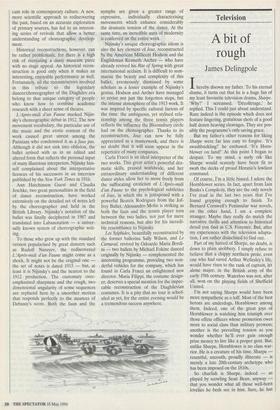Dance
The shock of the old
Giannandrea Poem
Vaslav Nijinsky's choreographic genius has been acknowledged by many scholars, researchers and journalists. Yet only a few people were able actually to assess the sig- nificance of his works because, at the time of their creation, they were considered too modem and too controversial and there- fore did not last long.
Most dance experts in the second half of the 20th century had to rely on second- hand, corrupted choreographic versions based more on a free, individual interpreta- tion than on a serious attempt at a faithful revival. The aim of the Omaggio a Nijinsky (Tribute to Nijinsky), given its premiere last week in Verona by the resident ballet com- pany, is to revise the standard, stereotyped notion many ballet-goers have of Nijinsky's choreography and to present a more accu- rate rendering of his extraordinary creative skills — not an easy task, yet beautifully achieved. Within the last 15 years, recon- structing lost dances has played a signifi- cant role in contemporary culture. A new, more scientific approach to rediscovering the past, based on an accurate exploration of primary sources, has led to an interest- ing series of revivals that allow a better understanding of choreographic develop- ment.
Historical reconstructions, however, can be rather problematic, for there is a high risk of recreating a dusty museum piece with no stage appeal. An historical recon- struction is good only when it makes an interesting, enjoyable performance as well. Fortunately, all the reconstructors involved in this tribute to the legendary dancer/choreographer of the Diaghilev era belong to that unique category of people who know how to combine academic research with a sheer sense of theatre.
L'Apres-midi d'un Faune marked Nijin- sky's choreographic debut in 1912. The new movement vocabulary, the particular use of the music and the erotic content of the work caused great unrest among the Parisians who condemned it as a faux pas. Although it did not sink into oblivion, the ballet arrived with us in an edited and altered form that reflects the personal input of many illustrious interpreters. Nijinsky him- self complained about the interpretative licences of his successors in an interview published by the New York Times in 1916.
Ann Hutchinson Guest and Claudia Jeschke, two great personalities in the field of dance reconstruction, have worked extensively on the detailed set of notes left by the choreographer and held in the British Library. Nijinsky's notation of the ballet was finally deciphered in 1987 and translated into Labanotation — a univer- sally known system of choreographic writ- ing.
To those who grew up with the standard version popularised by great dancers such as Rudolf Nureyev, the rediscovered L'Apres-midi d'un Faune might come as a shock. It might not be the original one the set of notes is dated 1915 — but, at least it is Nijinsky's and the nearest to the 1912 production. The customary over- emphasised sharpness and the rough, two dimensional angularity of some sequences are replaced here by a smoother motion that responds perfectly to the nuances of Debussy's score. Both the faun and the nymphs are given a greater range of expressive, individually characterising movements which enhance considerably the dramatic tension of the dance. At the same time, an incredible aura of modernity is conferred on the entire work.
Nijinsky's unique choreographic idiom is also the key element of Jeux, reconstructed by the American Millicent Hodson and the Englishman Kenneth Archer — who have already revived his Rite of Spring with great international acclaim. It is difficult to sum- marise the beauty and complexity of this ballet, erroneously dismissed by some scholars as a lesser example of Nijinsky's genius. Hodson and Archer have managed to revive not just the forgotten steps, but the intense atmosphere of the 1913 work. It was inspired by specific cultural factors of the time: the ambiguous, yet stylised rela- tionship among the three tennis players reflects the influence the Bloomsbury circle had on the choreographer. Thanks to its reconstructors, Jeux can now be fully appreciated as a masterwork, and there is no doubt that it will soon appear in the repertoire of many companies.
Carla Fracci is an ideal interpreter of the two works. This great artist's powerful dra- matic skills, praised worldwide, and her extraordinary understanding of different dance styles allow her to move freely from the suffocating eroticism of L'Apres-midi d'un Faune to the psychological subtleties of Jeux, in which she is juxtaposed with a powerful Beatrix Rodrigues from the Jof- frey Ballet. Alessandro Molin is striking as both the faun and the tennis player torn between the two ladies, not just for mere technical reasons, but also for his incredi- ble resemblance to Nijinsky. Les Sylphides, beautifully reconstructed by the former ballerina Sally Wilson, and Le Carnaval, revived by Odoardo Maria Bordi- ni — two ballets by Michael Fokine danced originally by Nijinsky — complemented the interesting programme, providing two won- derful vehicles for the company, which has found in Carla Fracci an enlightened new director. Maria Filippi, the costume design- er, deserves a special mention for the impec- cable reconstruction of the Diaghilevian costumes. It is a pity that no tour is sched- uled as yet, for the entire evening would be a tremendous success anywhere.



































































 Previous page
Previous page